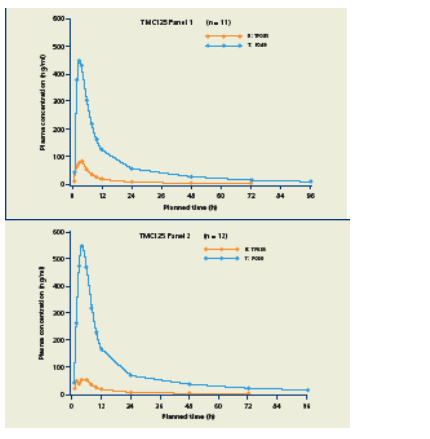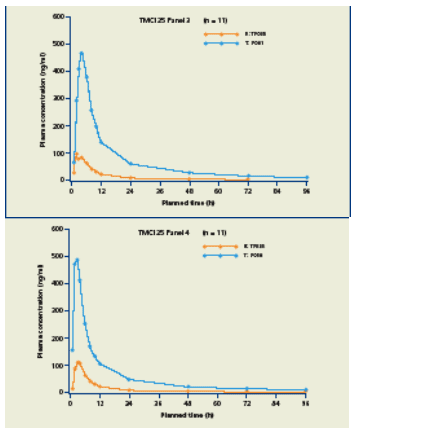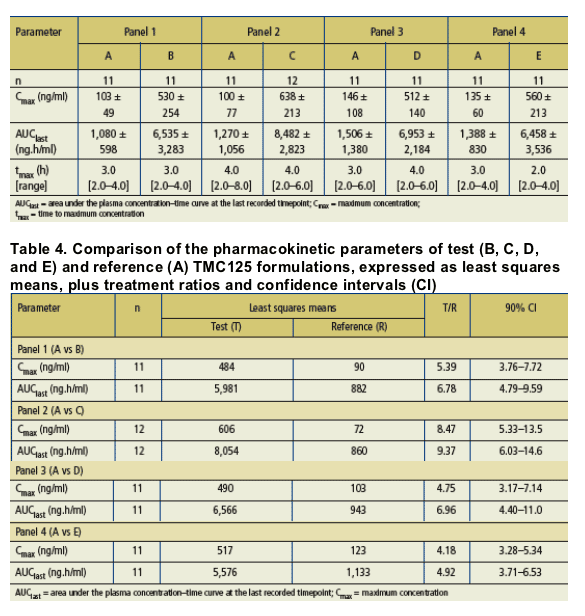 |
 |
 |
| |
Substantial improvement of oral bioavailability of TMC125
using new tablet formulations in healthy volunteers
|
| |
| |
Reported by Jules Levin
3rd Intl AIDS Society Conference
July 24-27, 2005
Rio de Janeiro
Poster No. TuPe3.1B11
Scholler M1, Hoetelmans R1, Beets G1, Vandermeulen K1, Peeters M1, Bastiaanse L1, Leemans R2, Debroye C1 and Woodfall B1
1Tibotec, Mechelen, Belgium; 2Johnson & Johnson Pharmaceutical Research and Development, Beerse, Belgium
AUTHOR CONCLUSIONS:
-A substantial improvement in the oral bioavailability of TMC125 has been achieved by means of reformulation. The novel formulations tested were all associated with significantly higher Cmax and AUC values compared with the reference formulation, while tmax was not affected.
-The new formulations were well tolerated in this single-dose study in healthy volunteers.
-The improved oral bioavailability of new formulations will allow a substantial reduction in pill burden, which offers the potential for improved convenience.
-Further work is ongoing to optimize a new tablet formulation of TMC125, to be used in Phase III studies.
INTRODUCTION
Non-nucleoside reverse transcriptase inhibitors (NNRTIs) are key components of
combination anti-HIV therapy. However, resistance in HIV-1 may rapidly develop
during NNRTI therapy, especially if adherence is suboptimal.1-3
-There is a need for new NNRTIs that are highly potent against viruses resistant to currently available NNRTIs, and that possess an increased genetic barrier to the development of resistance.
-TMC125 is a novel NNRTI with potent in vitro activity against both wild-type HIV
and HIV resistant to currently approved NNRTIs.4 The structure of TMC125
(C20H15BrN6O or
4-[[6-amino-5-bromo-2-[(4-cyanophenyl)amino]-4-pyrimidinyl]oxy]-3,5-dimethylbenzonitrile) is shown in Figure 1.
-TMC125 is currently in Phase IIb clinical trials, and has proven to have potent shortterm activity and be generally well tolerated in both antiretroviral-naive subjects and in those with NNRTI resistance.5,6
-Formulation TF035 is used in ongoing trials and is a 200 mg granulolayered tablet. New formulations of TMC125 have been developed to enhance oral bioavailability, reduce pill burden and improve convenience.
-We conducted a study (TMC125-C170) to determine the relative oral bioavailability of four of these new formulations, compared with the reference formulation TF035, in healthy subjects.
Methods
Study design
-TMC125-C170 was a randomized, open-label, single-dose, 2-period crossover trial in 45 HIV seronegative healthy subjects.
-Subjects were randomized to one of four parallel panels, each corresponding to a different TMC125 test formulation. All participants received, in a randomized order, a single 400 mg dose of TMC125 reference formulation (TF035; formulation A) and a single 400 mg dose of one of the four test formulations of TMC125 (formulations B, C, D and E; Table 1 and Figure 2).
Subsequent doses in the same subject were separated by a washout period of 2 weeks.
-All doses of TMC125 were administered with a standardized meal.
Table 1. Study TMC125-C170: TMC125 formulation identity and recipient panels

Pharmacokinetic analysis
-After each dose, plasma concentrations of TMC125 were measured over a 96-hour period using validated liquid chromatography-tandem mass spectrometry (LC-MS/MS) methods. Pharmacokinetic parameters were calculated from individual plasma concentration-time curves.
Results
Safety analysis
-Safety and tolerability were monitored by clinical laboratory tests, ECGs, vital signs and adverse event (AE) reporting throughout the study period.
Table 2. Baseline characteristics

Pharmacokinetic analyses
-All test formulations (B, C, D and E) had greater oral bioavailability than the reference formulation (A). The mean plasma concentration-time curves for each formulation are presented in Figure 3.
-All test formulations were associated with significantly higher area under the plasma concentration-time curve (AUC) at the last recorded timepoint (AUClast), AUC at infinity (AUC; data not shown) and maximum concentration (Cmax) compared with the reference formulation (P < 0.0001 for all comparisons).
Figure 3. Geometric mean TMC125 plasma concentration-time curves for a single oral dose of 400 mg TMC125 reference (R) and test (T) formulations in healthy subjects (n = 45)


-Pharmacokinetic parameters for the test and reference TMC125 formulations are presented in Table 3, with least squares means and confidence intervals shown in Table 4. Mean AUClast of the test formulations ranged from 492% to 937% of values for the reference formulation. For the mean Cmax, the range was 418% to 847%. The time to maximum concentration and elimination half-life were similar for all formulations.
-All primary pharmacokinetic parameters showed considerable variability between study participants; however, the test formulations each showed less inter-individual variation compared with the reference formulation.
Table 3. Comparison of single-dose pharmacokinetics of 400 mg TMC125 administered as reference (A) or test (B, C, D and E) oral tablet formulations to healthy subjects. (All data are expressed as mean ± SD, except for tmax where median and range are provided)

Safety analysis
-All formulations of TMC125 were generally well tolerated. No serious or severe (Grade 3 or 4) AEs were reported. The most commonly reported AEs are listed in Table 5.
-No discontinuations due to AEs or clinically relevant treatment-related changes in laboratory tests, ECGs or vital signs were observed.
Table 5. Most frequently reported adverse events (AEs) with the reference formulation (A) and four different test formulations (B, C, D and E)

References
1. Moyle G. Drugs 2001; 61:19-26.
2. Antinori A, et al. AIDS Res. Hum. Retrovir. 2002; 18:835-838
3. Harrigan PR & Larder BA. Antimicrob. Agents Chemother. 2002; 46:909-912.
4. Andries K, et al. Antimicrob. Agents Chemother. 2004; 48:4680-4686.
5. Grudez B, et al. AIDS 2003; 17:2487-2494.
6. Gazzard B, et al. AIDS 2003; 17:49-54.
|
|
| |
|
 |
 |
|
|